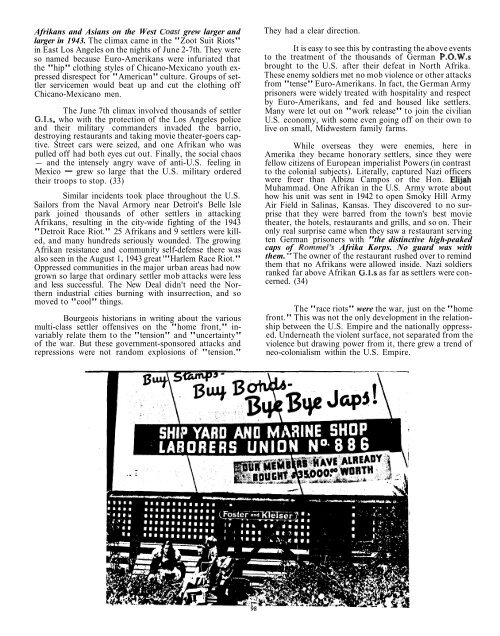Settlers - San Francisco Bay Area Independent Media Center
Settlers - San Francisco Bay Area Independent Media Center
Settlers - San Francisco Bay Area Independent Media Center
You also want an ePaper? Increase the reach of your titles
YUMPU automatically turns print PDFs into web optimized ePapers that Google loves.
Afrikans and Asians on the West Coast grew larger and<br />
larger in 1943. The climax came in the "Zoot Suit Riots"<br />
in East Los Angeles on the nights of June 2-7th. They were<br />
so named because Euro-Amerikans were infuriated that<br />
the "hip" clothing styles of Chicano-Mexicano youth expressed<br />
disrespect for "American" culture. Groups of settler<br />
servicemen would beat up and cut the clothing off<br />
Chicano-Mexicano men.<br />
The June 7th climax involved thousands of settler<br />
G.I.s, who with the protection of the Los Angeles police<br />
and their military commanders invaded the barrio,<br />
destroying restaurants and taking movie theater-goers captive.<br />
Street cars were seized, and one Afrikan who was<br />
pulled off had both eyes cut out. Finally, the social chaos<br />
- and the intensely angry wave of anti-U.S. feeling in<br />
Mexico - grew so large that the U.S. military ordered<br />
their troops to stop. (33)<br />
Similar incidents took place throughout the U.S.<br />
Sailors from the Naval Armory near Detroit's Belle Isle<br />
park joined thousands of other settlers in attacking<br />
Afrikans, resulting in the city-wide fighting of the 1943<br />
"Detroit Race Riot." 25 Afrikans and 9 settlers were killed,<br />
and many hundreds seriously wounded. The growing<br />
Afrikan resistance and community self-defense there was<br />
also seen in the August 1, 1943 great '"Harlem Race Riot."<br />
Oppressed communities in the major urban areas had now<br />
grown so large that ordinary settler mob attacks were less<br />
and less successful. The New Deal didn't need the Northern<br />
industrial cities burning with insurrection, and so<br />
moved to "cool" things.<br />
Bourgeois historians in writing about the various<br />
multi-class settler offensives on the "home front," invariably<br />
relate them to the "tension" and "uncertainty"<br />
of the war. But these government-sponsored attacks and<br />
repressions were not random explosions of "tension."<br />
They had a clear direction.<br />
It is easy to see this by contrasting the above events<br />
to the treatment of the thousands of German P.0.W.s<br />
brought to the U.S. after their defeat in North Afrika.<br />
These enemy soldiers met no mob violence or other attacks<br />
from "tense" Euro-Amerikans. In fact, the German Army<br />
prisoners were widely treated with hospitality and respect<br />
by Euro-Amerikans, and fed and housed like settlers.<br />
Many were let out on "work release" to join the civilian<br />
U.S. economy, with some even going off on their own to<br />
live on small, Midwestern family farms.<br />
While overseas they were enemies, here in<br />
Amerika they became honorary settlers, since they were<br />
fellow citizens of European imperialist Powers (in contrast<br />
to the colonial subjects). Literally, captured Nazi officers<br />
were freer than Albizu Campos or the Hon. Elijah<br />
Muhammad. One Afrikan in the U.S. Army wrote about<br />
how his unit was sent in 1942 to open Smoky Hill Army<br />
Air Field in Salinas, Kansas. They discovered to no surprise<br />
that they were barred from the town's best movie<br />
theater, the hotels, restaurants and grills, and so on. Their<br />
only real surprise came when they saw a restaurant serving<br />
ten German prisoners with "the distinctive high-peaked<br />
caps of Rornmel's Afrika Korps. No guard was with<br />
them. " The owner of the restaurant rushed over to remind<br />
them that no Afrikans were allowed inside. Nazi soldiers<br />
ranked far above Afrikan G.1.s as far as settlers were concerned.<br />
(34)<br />
The "race riots" were the war, just on the "home<br />
front." This was not the only development in the relationship<br />
between the U.S. Empire and the nationally oppressed.<br />
Underneath the violent surface, not separated from the<br />
violence but drawing power from it, there grew a trend of<br />
neo-colonialism within the U.S. Empire.

















